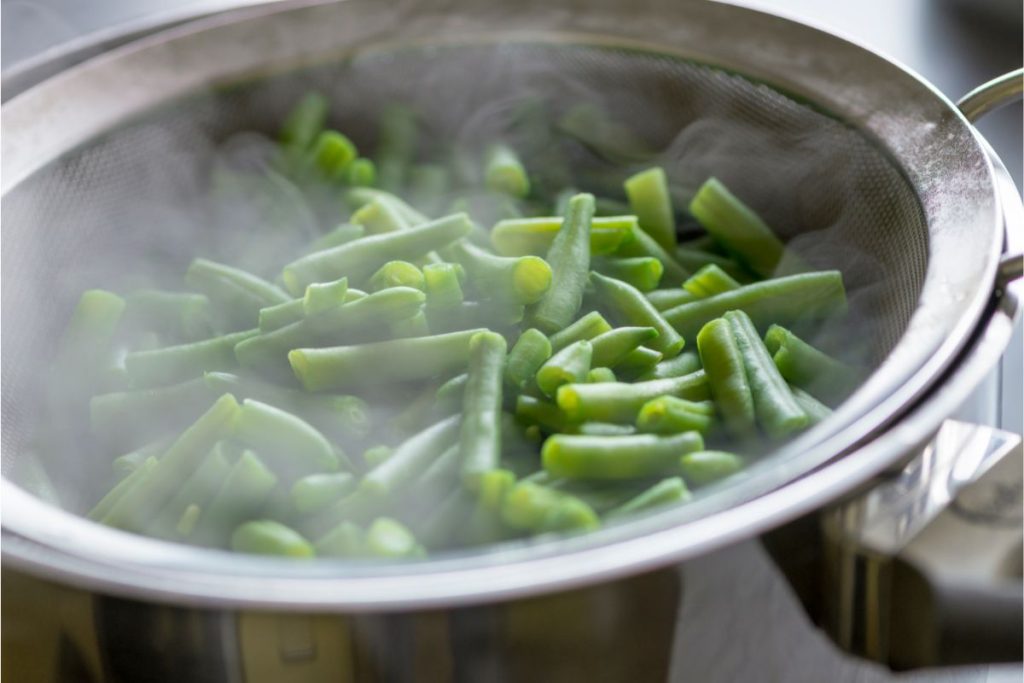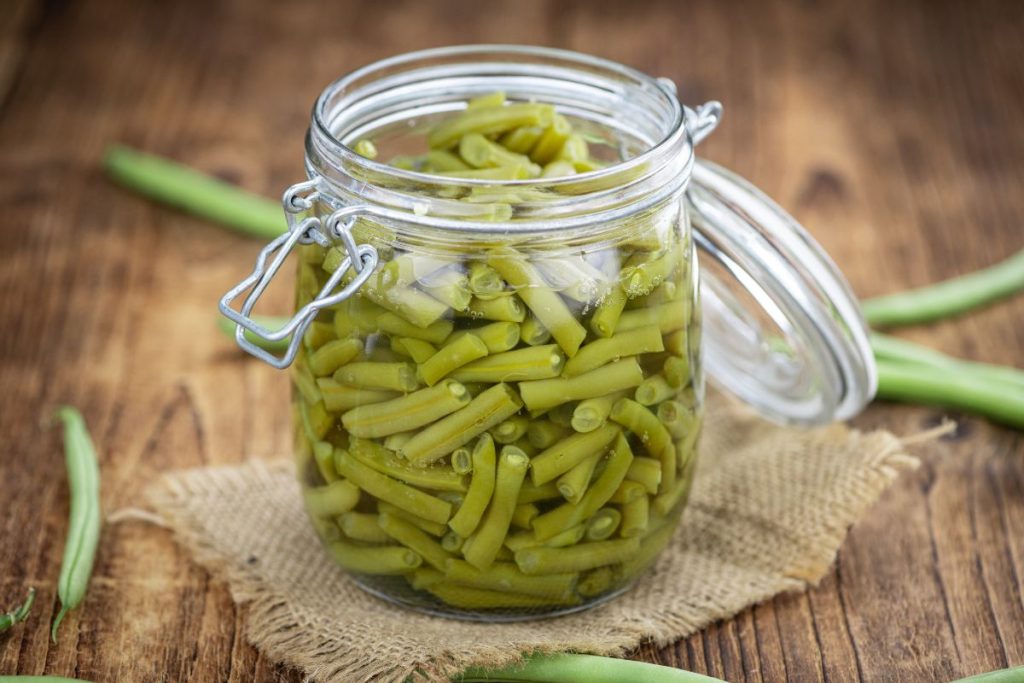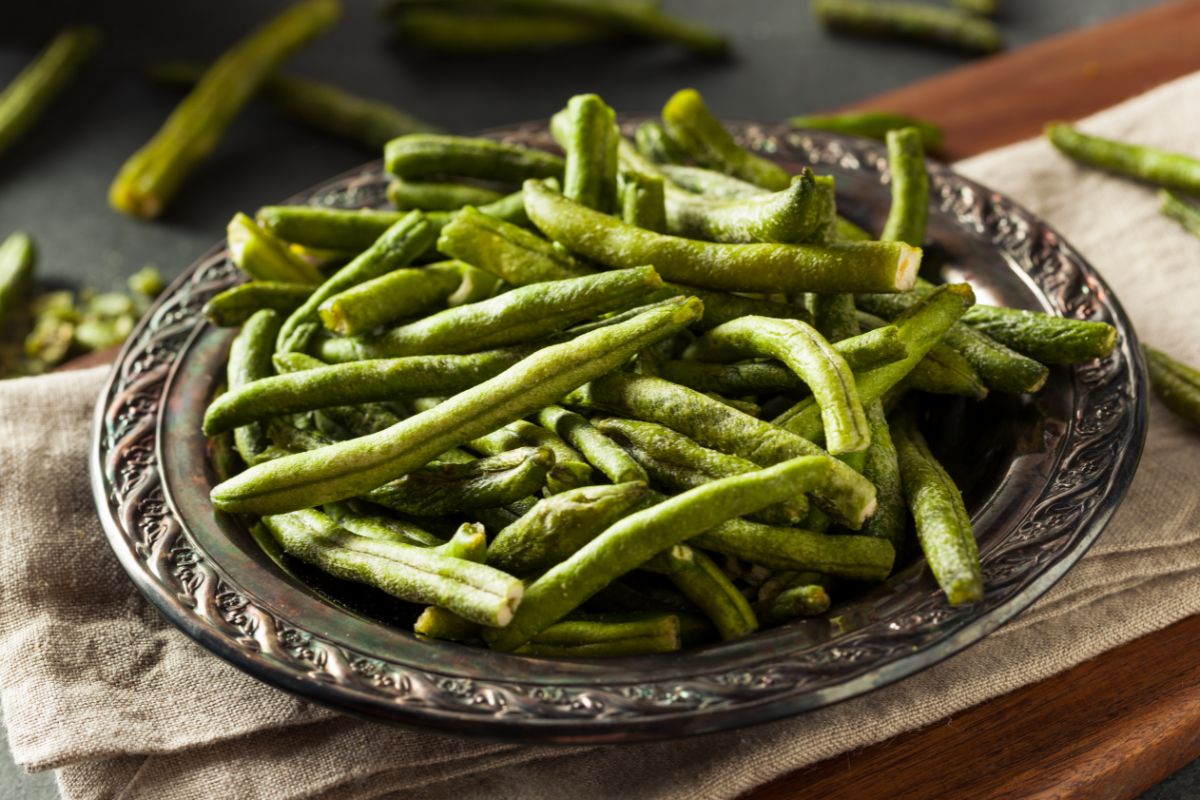To dehydrate green beans, rinse and blanch them. Place them in a single layer on a dehydrator tray and dry them at 125°F for 6-8 hours in a food dehydrator. The beans are done when they are crispy and snap when bent.
Table of Contents
How to Dehydrate Green Beans in a Food Dehydrator
The best way to dehydrate green beans is to dry them in a food dehydrator:
- First, wash your green beans and snap off each end to remove the stems.
- Before dehydrating, blanch the beans in boiling water for 5 minutes, and then submerge them in ice water to stop further cooking.
- Drain the water and chop the beans into one-inch pieces.
- Lay the beans out on a dehydrator tray in a single layer. Make sure there is space between them to allow for airflow and even drying.
- Place the trays in a food dehydrator with the temperature set to 125°F.
- Green beans take between 6 and 8 hours to fully dehydrate. Check them every couple of hours, testing for dryness. Do this by removing a few pieces and allowing them to cool. If they are crispy and snap when bent, the beans are fully dry.
- Once the beans are fully dry, remove them from the dehydrator and allow them to cool to room temperature.
- When the beans are cool, store them in an airtight container in a cool, dark, and dry place for long-term storage.

Oven Dehydrated Green Bean Chips Recipe
- Total Time: 3 hours, 5 minutes
Description
Dehydrated green bean chips are a healthy snack. Not only are they tasty, but these green bean chips are low-carb, fit within the keto diet, and are gluten-free! Ditch potato chips for this crispy side dish instead.
Ingredients
- 3 tbsp extra virgin olive oil
- 3 cups frozen green beans
- 1 tsp sea salt
Instructions
- Preheat your oven to 250 degrees Fahrenheit.
- Pour your frozen green beans into a large bowl. Frozen beans come fully prepped (blanched and chopped), cutting down on your prep time.
- Cover the green beans with olive oil and salt, and mix using your hands to get an even coating.
- Cover a baking sheet with parchment paper. Lay out the beans in an even layer on top of the baking sheet, ensuring they are evenly spaced and in a single layer.
- Once the oven is preheated, place the loaded baking sheet on a low shelf inside the oven. Let the beans dehydrate for 1.5 hours.
- After an hour and a half, remove the beans and flip them to ensure even drying. Place them back in the oven for a further 1.5 hours.
- Test your beans by removing a few pieces, allowing to cool, and snapping them. They are done when they are crispy and crunchy. Continue drying if they don’t snap.
- Remove from the oven once the green beans are dry, and cool them at room temperature before storing them.
- Prep Time: 5 minutes
- Cook Time: 3 hours
Nutrition
- Serving Size: 20g
- Calories: 118kcal
- Sugar: 0.9g
- Sodium: 1g
- Fat: 10.3g
- Carbohydrates: 6.5g
- Fiber: 3g
- Protein: 1.5g
How Can You Tell if Dehydrated Green Beans are Done?
Green beans are fully dehydrated when they are crispy to the touch. They should snap rather than bend. If they have any give, they need to be dehydrated longer.
Can You Dehydrate Fresh Green Beans?
Yes, you can dehydrate fresh green beans. Dehydrating fresh beans works as well as dehydrating the frozen kind. However, there is more prep work required when using fresh veggies because they will require blanching.
Do You Need to Blanch Green Beans Before Drying Them?
Yes, you do need to blanch green beans before dehydrating them. Blanching involves submerging the string beans in boiling water for 2-5 minutes before submerging them in ice-cold water to stop the cooking process.
Blanching is required for many veggies because it kills the enzyme processes that cause discoloring and flavor degradation in your vegetables, which aren’t stopped by the dehydration process. Without blanching, dehydrated green beans would lose quality sitting in food storage.

How to Rehydrate Dried Green Beans for Meals
Rehydrating dried green beans is easy and only requires a heat-safe bowl and water.
Place your green beans in a bowl, and cover them with boiling water. For every cup of beans, you need three cups of hot water.
Let the beans soak for an hour until they regain their original texture. Cook the rehydrated green beans before eating them.
Here are some tasty recipe ideas for your rehydrated green beans:
- Add them to a casserole with onion and mushrooms
- Combine with almonds to make green-bean almondine
- Make a winter vegetable soup by combining them with potato and broccoli
- Sautee them with garlic to make a tasty side dish

What is the Difference Between Dehydrated Green Beans and Canned Green Beans?
Dehydrated green beans are made by using heat and airflow to remove the water content from the beans, preserving them. Dehydrating green beans does not cook them.
Canned green beans are beans that have been preserved by processing in a high-heat environment in a pressure canner or boiling water bath canner. The canning process cooks canned green beans.

How Long Do Dehydrated Green Beans Last?
Dehydrated green beans last for up to a year when stored properly.
The best way to store dried green beans is in an airtight container in a cool, dark, and dry room. Moisture and heat accelerate the spoiling process, so keep away from humidity and direct sunlight.
Another option is to store dehydrated vegetables in the freezer. Simply place them in a vacuum-sealed bag. Remember that dried veggies are brittle and easily crushed, so don’t put heavy things on top of them.

